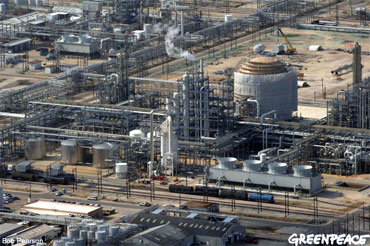Although we’re well aware of the impact the fossil fuel industry has on the lack of action on climate change, there’s another powerful special interest group we rarely hear about – the chemical industry.
Since 2005, attempts to reform and update the 36-year old Toxic Substances Control Act have been prevented by the industry.
In July, the Safe Chemicals Act (S.847) was passed in the Senate Environment and Public Works Committee, which would, for the first time, make chemical manufacturers prove their products are safe before being allowed for sale. That burden of proof is currently on the EPA, which can never find the time or resources to evaluate thousands of chemicals.
But a vote on that bill has never made it to the Senate floor because over the past seven years, chemical industry groups have spent a mind-boggling $375 million to block the bill, according to an analysis by Common Cause.
And that’s after a President’s Cancer Panel in 2010 found that public health officials have "grossly underestimated" the likelihood that environmental contaminants trigger a large proportion of the cancers diagnosed in 1.5 million Americans annually.

In the 2012 election cycle alone, chemical interests spent $23 million to support candidates friendly to their cause and to oppose adversaries. The industry’s chief advocacy arm, the American Chemistry Council, spent an additional $2.8 million on political advertising, says Common Cause.
78% of chemical industry contributions went to Republicans in the 2012 election, and Mitt Romney received more than triple that of President Obama ($700,000 compared to $200,000).
Gene Green (D-TX), the senior Democrat on the subcommittee that controls chemicals policy, received $400,000 for his 2012 campaign.
There’s been better luck on the state level, where 18 states have managed to passed over 80 chemical safety laws in the last nine years – by an overwhelming margin with broad bipartisan support.
Chemical Industry Impacts
Increasingly, chemicals in common household products are implicated in the huge rise in cancer, diabetes, falling fertility and other serious health issues, often in just trace amounts.
Some of these chemicals – such as the perfluorooctanic acid (PFOA) used in non-stick coatings – are found in the bodies of 99% of Americans and have polluted the water in at least nine states. Others, such as the cancer-causing chlorinated-Tris, are used in the foam in furniture such as sofas as a flame-retardant, and are even found in infant and toddler products.
DuPont, the only American manufacturer left that makes PFOA, has committed to phase it out by 2015, but it’s still produced by companies overseas and no US law requires that screening for replacement chemicals.
The American Chemistry Council is also actively opposing a change in LEED certification for buildings that would credit designers for not using materials that contain these chemicals.
And chemicals are ubiquitous, in everything from packaged food and plastics, to cosmetics and pharmaceuticals.
Yet industry resistance against efforts to strengthen chemicals regulations remains overwhelming – especially after the Supreme Court’s Citizens United ruling that cleared the way for companies to spend unlimited sums in political campaigns.
The industry is also pushing against chemical disclosure in natural gas fracking and was a key opponent prevening passage of GMO legislation in California.
Some companies, such as Johnson & Johnson, are bowing to public pressure to provide safer formulations of their products. But there are plenty of loopholes in federal law that allow the chemical industry to continue with its business-as-usual approach of deciding what’s safe, regardless of independent evidence that suggests otherwise.
Vulnerable Chemical Plants
And what about all those chemicals being stored in thousands of chemical plants? Or shipped via rail?
In addition to being vulnerable to accidents and cyber attacks, during Hurricane Sandy a 22-car freight train was knocked over in New Jersey, one of the most densely populated areas of the US. If just one of those rail cars carried a poison gas such as chlorine and it had ruptured, more than a million people would be at risk of immediate injury or death.
There are 38 high risk chemical plants in New Jersey, New York and Pennsylvania that each put 100,000 or more workers and residents at risk, and when they suddenly lose power, the situation is even more dangerous.
Yet, since 9/11/2001, the industry has managed to prevent legislation that would prevent chemical disasters at high risk chemical plants.
One exception is The Clorox Company, which since 2009 has converted all its plants to safer processes.
If 20% of current production shifted from petrochemical-based plastics to bio-based plastics, it would also benefit the economy with over 100,000 more jobs. In fact, green chemical-makers led in venture capital investments last year.
Read the Toxic Spending report:
